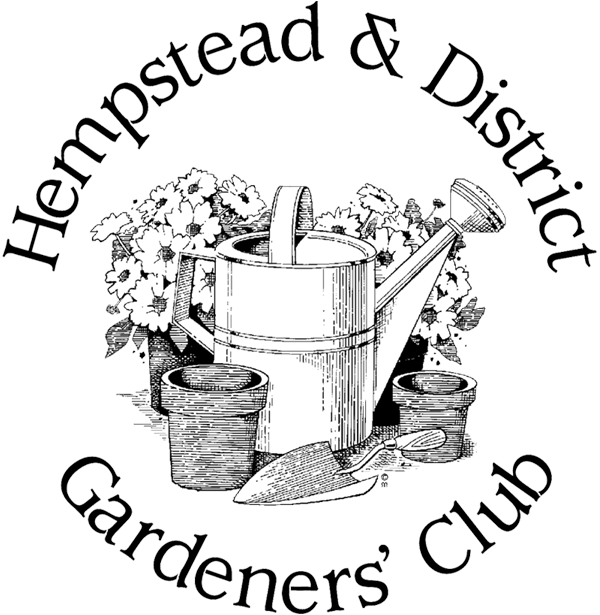|
|
Intro | Events | Shows | AGM | Monthly Tips
Cutting Garden | Gardening Year | Archive
|
The Gardening Year |
2010 | 2011 | 2012 | 2013 | 2014 | 2015 |
The Gardening Year 2015 |
|---|
| We were spared much in the way of winter storms over 2014/15 and with the exception of a couple of rainy days in January, the weather was very calm and without noticeable snow. Rainfall remained limited throughout Spring with only 100mm (4”) falling over March, April and May. |
| These gentle conditions allowed all the Spring flowers to bask in full glory with daffodils being spared their usual battering of cold wind and rain. Tulips stood upright and the early garden was a sight of beauty. And without the rain came warmth, so much so that the birds nested almost two weeks earlier than usual with fledged blue tits and great tits in the trees and shrubs by late May instead of early/mid June. |
| Of course the birds time the arrival of their young to coincide with the trees coming into leaf and the availability of caterpillars and the like. Oaks sprouted well ahead of ash this year with our huge ash tree almost undecided as to whether to bother to leaf at all. Eventually it did. And the magnolias were magnificent this year without frost to catch their unfurling flowers. I don’t think I have ever seen so many blooms on them. |
| The ground warmed early this year but we held off planting our potatoes until the usual day of Good Friday. Whilst many now try the no-dig policy, we still dig our veg patches over, as much to get rid of the deep-rooted perennial weeds as anything, and then the hoe can do its work for most of the growing season. |
| Seedlings grew well in the greenhouse with plenty of early sunshine so the coldframes were much needed once the plants were too big for the heat of the greenhouse but still in need of protection from the cold night-time temperatures. And nights did stay cold until well into June. A good dollop of rain was much appreciated on the 15th June but the following month was mostly dry and with one very hot week in particular. |
| I don’t like to waste water by watering the garden, but I do water when it gets very hot using just enough to keep the plants alive until some rain arrives. Silver leaved plants are always more tolerant of drought but the lupins and delphiniums were glorious in May because they were ahead of the driest conditions. Roses which appeared at the end of June struggled with the heat and unless they were good varieties, the flowers only lasted a day before the petals wilted away – such brief splendour. |
| A plant I recommend to every garden is Hesperis (Sweet Rocket). A packet of seeds will produce spires of mauve and white flowers in mid Spring which give height and grace to the garden when most plants are still quite short. I leave the seed heads on mine and let them self-sow around for future years – what a great value plant. |
| Hanging baskets benefitted from a lack of thunderstorms and hail storms to destroy them as soon as they were hung out, but after a promising start, the cold nights of early summer put paid to full development and they never fulfilled their potential. Trailing alyssum looks pretty in baskets early on, then dies off but has a second flowering in late September when the rest of the basket look shabby. |
| In the garden, the new range of hydrangea colours make them a fabulous addition whether you choose to grow them in large pots or in the ground. Coming from North London they were an integral part of many gardens there, often by the front door and growing so large that you could barely reach the door itself. I am delighted to see them make a comeback. And a great discovery of 2015 was Lobelia Tupa – not like the tiny hanging basket lobelia but a 6’ tall giant for the border with red flowers climbing the spire from July-October. |
| Of course the muntjac visited and took the top off some of my sweet peas, but as it turned out the sweet peas were not up to much anyway. This is the poorest year I have known for them and I can only put it down to cold nights in June and intermittent rain. By contrast, a standard fuchsia in a pot brought out from over-wintering in the greenhouse went beserk and nearly fell over with so many flowers. |
| Dahlias remain a great joy if you can be bothered to give them a frame to sit in when you first plant them out. Once established, their bright, full heads of cactus, water lily or pom-pom styles pop up above other plants in the garden and make great cutting flowers too once you’ve shaken the earwigs out. |
| This year’s worst bug infestations came from the tiny black beetles, green fly and black fly arriving before ladybirds were about. I had clouds of the black beetles on the patio and they swarmed all over the bright orange day lilies (hemerocallis). I sprayed one flower once to see what would happen and when I tipped the flower head out the following day, the dead beetles made the same sound as rice poured from a jar, there were so many! |
| Our rainfall was erratic but when we did have 36mm on the 24th July and 43mm on the 26th August, it fortunately fell as steady rain over a day which was perfect for the plants. Short bursts of heavy rain do not reach deep into the ground and plants struggle in those conditions but continuous, penetrating rain produces great results and the dry periods that followed allowed flowers to stand proud with blooms open for the longest time possible. |
| Like Monty Don on Gardeners’ World, we had mixed successes in the greenhouse with limited sizes of crops. The tomatoes were not abundant but had glorious flavour and the green peppers did well while cucumbers and melons were fairly disastrous. The fruit cage produced average crops of raspberries and currants but the veg patches needed more regular water than nature provided. None-the-less potatoes were excellent, as were all the courgettes, runner beans and French beans. Salad crops were not so good and as usual, the muntjac had the broad beans. The vegetable stall of my neighbour opposite offered a splendid array of produce all summer possibly due to more consistent watering than we managed. |
| The crab apple trees were abundant and the harvest of eating apples and pears was magnificent. And barely had we gathered the last apples than the leaves began to fall. Balmy days lingered through late September and October with flower borders still looking remarkably good before the rains set in. There is talk of this winter being a very snowy one, so spare a thought for the small birds and retain seed heads where possible and put out feeders. The flock of goldfinches that stayed through Spring this year were a delight and I hope they will return along with winter visitors such as the redstarts. |
| Diana Frost |
| (Top of page) |
The Gardening Year 2014 |
|---|
| It has started raining significantly in mid-December 2013 and unusually, never broke to a cold spell. A thunderstorm on Jan 3rd directly overhead produced loud thunder, strong lightening and hail. But it still didn’t turn cold. Instead the rain continued and the ground became more and more saturated until breaking point was reached and flooding began with rivers overflowing and water simply bubbling up through homes, tarmac and everything. A further 34mm of rain fell on Hempstead on Thursday night, 6th Feb which led to most roads flooding and becoming impassable and many people had trees down, fences gone and tiles off roofs; yet more storms came the following week until the morning of Sunday 16th Feb when we awoke to blue skies and sun and barely a breath of breeze – you could smell Spring in the air instantly. |
| I stepped outside my back door and surveyed the debris, damage and the neglect of winter as I never cleared the garden properly before winter set in. What a mess! One old tree down, bits of ash trees broken off everywhere; everything bedraggled, blown about and black. The ground was very heavy under-foot and digging was out of the question, but primulas and hellebores were out and the snowdrops looked magnificent. How can something so delicate put up with all that wind without getting their heads torn off? And on closer inspection, the clematis had not only budded but had broken into leaf - a quick short, back and sides was urgently required. | 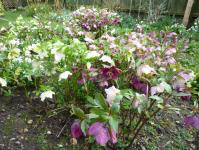 |
|
| Out came the heated propagator and the first packet of seeds and I was off! – a new year of gardening had begun. |
| We had a few more showers but the worst of the weather was past and nature recovers so quickly. There was hardly time to look round before the daffodils opened and Easter loomed. I love that colour combination of lemon and mauve in Spring – crocus, violets, pansies, daffodils, narcissi and tulips paint wonderful drifts and lift your heart no matter the weather. Always have plenty of pots of successional bulbs to hand and put them in places that you pass all the time. Bulbs are highly undervalued as instant colour and I strongly urge you to plant up more as they cover every season in the year and have some of the richest colours in the palette. |
| The greenhouse became busier and busier as seeds germinated each week from the heated propagator. But April was a dry month this year with good light levels and the baby plants flourished so we were soon constructing our temporary cold-frames and moving the plants into them. The garden equally loved the dry spell and stayed about four weeks ahead of its usual season. A magnificent display of primulas and primroses was followed by one of the best years for tulips that I can recall. |
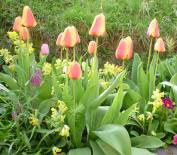 | I have to confess disappointment at one particular patch of tulips. Last year I carefully planted a dozen burgundy bulbs in refreshed earth at the correct depth, on gravel, in a sheltered space but leaving the ground above clear. They were magnificent in their first year. But this year only two re-appeared and they fell over looking very dismal. Meanwhile, a short distance away in a solid section of old, solid clay earth that has been neglected and unloved for years, a selection of ten year old tulips popped their heads up through primulas, poppies and a potentila in pristine condition. I think they did it for spite but they were lovely none-the-less. |
|
| On the heels of the tulips came the delphiniums and lupins with the first delphinium showing blue on the 7th May. This was extremely early but they took three weeks to fill their spires as the cool nights of May checked their growth. May was a mixed month, glorious mid month but most memorable I am sure for the poor weather at the Bank Holiday weekend at the end of the month. The Saturday 24th was Gardeners’ Mart day and it was raining from 6am. This was our 15th Mart and the first one that actually took place in the rain. |
| I had a moment of panic. After we had loaded several trailers full and Nigel had driven them to the bus-stop where the trestle tables were laid out, I jumped in beside him just after 9am (we were running a smidge late) to go and start selling. And suddenly I looked at the rain on the window and thought “what have I done? I’ve grown all these plants which no-one will want on the dreadful day and I will have wasted a large amount of the Club’s money”. Nigel told me to stay calm and that some people were already there when he had delivered the last load. We reached the point down the High Street where you can get your first glimpse of the bus-stop area - and all I could see was people’s backs - hooded, rain-coated, umbrellas up and no sight of the trestle tables at all there were so many people. What fantastic, supportive villagers you all were! People from the Ashdon Club came, Radwinter friends and more – all mixing with our own Hempstead gardeners. I can’t tell you how thrilled
and grateful I was and the end result was highly successful with almost nothing left. Thanks to everyone who helped make the event happen and to all of you who came and bought from us. |
| The Mart itself is not the end. Some people find they need more when they have planted them out at home and I get a series of phone calls and visitors for “extras”, which is great. We take some plants to those who can’t get out of home but who would like to support us; we plant up the village tubs and troughs and we have been kindly asked to fill the hanging baskets for the Bluebell Inn in recent years. My favourite reason from someone needing more plants this year was “the pigs got out and ate the geraniums I had bought” – now you don’t hear that one every day! |
| The weather immediately after the Bank Holiday chucked it down with 38mm in the next three days and while a couple of small plants struggled and drowned, most took on the strength that only rain can provide and grew lustily. A few days later and the garden was radiant and healthy with Inula (Christopher Lloyd’s huge yellow daisy plants at 5’ and 7’ tall) really enjoying the wet. Phlox, a woodland native not in flower until July/Aug, always looks good after rain because it is shallow rooted, but clematis needed help as it had been beaten down. Early June warmed up nicely and a cuckoo sang beautifully from a nearby tree on the 12th – so lovely to hear before they depart again. |
| And so it turned into the most glorious summer. A few spectacular night-time storms with lots of lightening and the odd downpour but predominantly sunshine and high temperatures all the way. July proved to be the ninth month in a row with above average temperatures and the garden, although dry, loved it with glorious flower displays. By the start of August the dahlias were out, alongside cosmos, heleniums, asters and the second flush of roses. Evening scent on the patio was glorious from potted petunias and nicotiana with zinnias playing a great role is keeping everything upright in the border. |
| Hanging baskets were difficult to keep wet in the prolonged dry spells and needed watering at least twice a day but my favourite basket this year contained pink/white fuchsias mixed with white nemesia, cream and purple Tumbelina petunias and pink calabrachoa – a profusion of colours but with a lovely summery result. With regular feeding, it still looked excellent at the end of September. |  |
|
 | Other favourites this year include Cuphea llavea ‘Tiny Mice’ which is unusual and good in the centre of tubs as it stays quite upright; nasturtiums, which amazingly did not get blackfly or eaten by caterpillars at all this year. (The climbing variety I found only moderately successful with not many flowers.) And my pot of tumbling roses, although only small, produced frilly, attractive blooms all summer long. |
|
| The fruit cage produced a good crop of red gooseberries despite one branch suddenly dying. Hopefully it won’t affect the rest of the plant for next year. If you only know green gooseberries then you will be thinking of very sour green berries that take lots of sugar to make them acceptable. Red gooseberries are completely different. They are a dessert fruit, making perfect crumbles with a fantastic coloured, deep red juice and we only add a tiny amount of sugar, if at all. Try a plant next year. | 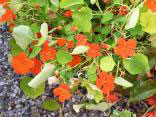 |
|
 | While August had many cloudy days it was dry enough for farmers to bring in the harvest earlier than usual and without late rain or storm damage. Surprisingly the plum crop was later than usual, probably because of the dryness but was excellent when it came and without wasps – where were they this year? September was the best weather I can recall. Long days of gentle breezes and warm sunshine and  although dry, the garden loved it. The late summer borders were superb this year with Rudbeckia Goldstrum playing a major role amid Madia, Strawflowers, Evening Primrose, dahlias, roses, Callicarpa Bodinieri and some very late but absolutely glorious, sweet peas. The Datura (or Brugmansia) was beautiful right through September. |
|
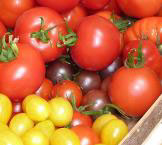 | The greenhouse benefitted from the high light levels too with our best ever crop of green peppers, aubergines that ripened well and a fabulous array of several types of tomato. In the veg patch, runner beans performed very well and whilst the potatoes had some scab as usual, the crop was very sound and plentiful. Lettuce and summer salads needed plenty of watering and diligence to keep the slugs at bay, the swede looked healthy and the spaghetti squash was quite prolific. The Becky pumpkin only produced two modest fruits whereas I had expected more and the crop of apples was in very good condition. |
|
| And suddenly the leaves of the phlox were showing mildew, spiders webs appeared everywhere, daddy long legs put in an late appearance and the morning mists arrived - Autumn was on its way. Friday 2nd October was a balmy 20C but rain arrived on Saturday and a shift in the jet stream brought a very cold night with a tiny touch of frost and that was it. |
| It has been the very best of British summers this year with little wind, meaningful rain when it came and very few insects. As I move the clay pots back into the greenhouse for winter and line it with bubble wrap, I ponder what lies ahead for this winter’s weather.... |
| Diana Frost |
| (Top of page) |
The Gardening Year 2013 |
|---|
|
Jan the 1st dawned with beautiful, blue sky and sunshine, casting away thoughts of the 827mm of rainfall in 2012 - our highest ever recorded. As gardeners, our wish was that 2013 would be drier and with fewer slugs.
 | The first seed and plant catalogues had dropped through my door between Christmas and New Year, at a perfect time when you have a few mins to browse the pages and dream of balmy, warm evenings and a flowered-filled patio. I eagerly thumbed the pages and made my selections, realised I had been over-ambitious and needed a new mortgage to pay for them, and promptly reduced the order by half. Does everyone do that? |
| A few seed packets arrived and the annual ritual began with cleaning the thermostatic propagator, sorting some pots and buying new compost. My advice is never to plant your precious new acquisitions in last year’s compost; chuck that on the garden and start with a fresh, new bag of your chosen variety. The propagator did its job but what the germinated seeds had to contend with afterwards was unbelievable. The coldest March for 40 years, no sunlight or warmth, bitter winds, snow and ice – I was putting down overnight fleece inside the bubble-wrapped greenhouse to try to keep things alive. | 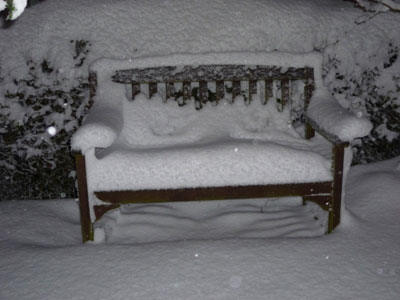 |
Nothing was developing and by post Easter at the beginning of April, the plants were a month behind in development. With the Gardeners’ Mart, the large annual plant sale in Hempstead, only six weeks away, it looked like we would have almost nothing to offer. Most definitely, I thought, plants would be half their normal size and with no flowers. And the weathermen continued to tell us that the jet stream was sitting too far to the south and that there was no end to the cold weather in sight.
At least you can amuse yourself in a greenhouse, fiddling about with seeds and pots. Outdoors was hopeless. Snow and ice covered the garden which was completely sodden and chilled underneath. The grass had not started to grow; hedges and tress showed no sign of budding up. By Easter my garden still had not produced an open, full-sized daffodil. The refreshed stock of tête-à-têtes at the village triangle had just managed to colour-up but were stunted in size and with their heads bowed against the icy winds. If and when Spring arrived, it was going to be a short one.
In the second half of April the temperatures lifted, the sun came out and plants raced out of the ground. They had a good two weeks growing before a dull and cold month of May. Nature is amazing at holding back and catching up when it needs to. As predicted, there were few flowers on our plants to offer at The Gardeners’ Mart on the 25th May but the plants themselves had developed beautifully by then – strong and healthy, so while we have be-moaned the temperatures, they had managed quite well.
| And so it was when you looked around the garden and the countryside. A deep winter of extended cold plus last years’ high rainfall and underground water stores replenished had given tress a perfect rest and they produced a magnificent display of blossom and a vast quantity of foliage. Hopefully there were enough pollinators around in the chilly days to set the blossom, but at the end of May everything was bursting with life and growth. |  |
| Other benefits had been the length of flowering time for bulbs such as narcissi, daffodils, grape hyacinths, camassia and tulips. I urge people to buy and put more bulbs into their gardens – they are so under-rated, and the tulips that we sold at last years’ H&DGC Autumn Show produced magnificently uniform, strong flowers. The polyanthus, primulas and cowslips had also lasted for weeks. With the increasing warmth and spring showers of course, came the slugs and snails again but most plants had romped away before they got going so the problem was better contained. | 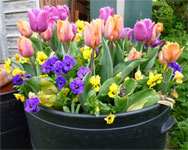 |
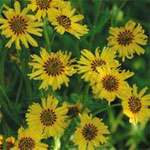 | At the turn of May into June I planted up tubs, troughs and hanging baskets trying some new plants along the way. Recommendations from my trials include Lobelia Richardii (stronger than ordinary lobelia) and Blue Ice which has a true royal and white coloured flower, and Madia for a new border plant - like an astrantia but with a yellow button flower and red tinged centre. |
| I wanted to try the new Geraniums called ‘Custard Cream’ – which are a delightful creamy yellow colour. I don’t always like it when they make strange new colours of plants but as I love blues and creamy yellows together I forgave them this diversion with the geraniums. And did it do exactly what it said on the tin? – well we’ll have to wait another year to answer that because they has sold out and I could not get any. Bah humbug! |  |
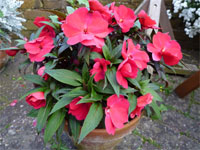 | June came and the temperature slowly rose and rainfall faded away. The garden raced ahead and without storms, hail or devastating winds, everything looked a picture. July turned hot, with no rain at all for three weeks and the garden was glorious – a bit droopy towards the end of this time, but lovely. Everything that should stand upright did, slugs were not to be seen and even the lettuce survived remarkably well. In fact the lettuce class was one of the best entered at the Annual Show on the 13th July, in the middle of the hot spell. |
Of course the veg classes generally had fewer entries this year as the late Spring had put paid to any veg being ready early, but in all other classes and areas the Show was really well entered and attended. There were plenty of roses with wonderful scent filling the Hall and some great cookery entries plus an excellent contribution from the children of Radwinter Primary School. Even the troughs at the front of the hall looked worthy of entry with their lemon tagetes, bright geraniums and mixed fuchsias. All in all a very good day.
Elsewhere around the village, the tub of marigolds and red salvias at the bottom of Church Hill performed very well and the geraniums and half-price shrivelled fuchsias purchased for the Village Hall troughs turned into beautiful plants that flowered profusely. I put that down to good drainage, a thorough watering once every three days and a fresh compost mix of two-thirds MiracleGro and one-third John Innes No. 2.
Some steady rain at the very end of July was a very welcome break from the watering and plants are always so much happier with ‘the real thing’. And it was the right sort of rain at first too – falling at night, for more than one night, and enough to soak into the ground. The fruit trees really needed it. Their boughs had drooped incredibly under the weight of fruit and the stress of dry conditions.
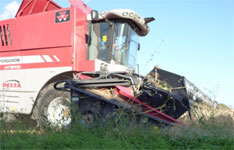 | It was at this point that you realised how well everything has caught up despite the length of the cold Spring. Tractors were soon busily charging up and down bringing in the harvest, with barley quickly followed by rapeseed, then wheat, broad beans and finally sugarbeet. I had spotted the odd field of linseed and borage in nearby villages, both with their distinctive, pretty, blue flowers – so lovely to see. |
Meanwhile I was considering what had been successful and what not, of the plants I had grown and experimented with this year. My conclusions are as follows:
Climbing geraniums – pretty good. Definitely needed their frame and had to be constantly pushed back inside it to keep the shape. They certainly did not reach the height shown in the advert picture.
Bush petunias – too big, flopped all over the place crushing other plants in the tubs and looked very unattractive, very quickly.
Straw flower – I had forgotten how simple and pleasant these old fashioned flowers are that you can use in wet or dry displays. Good but need staking.
Nemesias – the ordinary multi-coloured bedding variety performed well until it rained heavily. The new varieties that you buy singly for tubs and baskets at over £2 each did fantastically well, maturing slowly and in very unusual colour combinations - excellent.
Lobelia Richardii and Blue Ice – started to die off around the outer edges from the first week of August so performed no better or worse than conventional lobelia but the strength of colour they produced was striking.
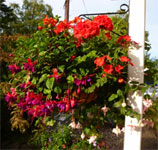 | All baskets and tubs did very well until the end of August at which point even feeding didn’t seem to help much. Only geraniums, fuchsias, marigolds and bedding begonias have the longevity to carry on right through September. |
| Of the border plants everything did well. The late Spring bloomers such as lupins, delphiniums, alliums and roses loved the hot spell with gentle breezes, and the rain suited the later summer bloomers of phlox, sunflowers, dahlias, monarda, rudbeckias and heleniums. Gardeners are well known for never being happy with the weather but I have to say this was as good as it gets this year and whilst it was a long wait to get started, it was a fabulous summer when we got there. | 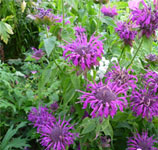 |
And the vegetables ? All potatoes and salad crops were good. I found growing lettuce in a tub of fresh multi-purpose compost much cleaner and less damaged than when grown in the ground. Runner beans needed spraying at night to help the flowers germinate and develop as they don’t like hot nights. Produce from the greenhouse was excellent. The Canteloupe melons were a very good size and with very good flavour from the hours of sunshine, as were the peppers, tomatoes and cucumbers – all lovely.
Soft fruits of strawberries, raspberries, and all the currants and gooseberries were late but good. And after a poor year last year, the plum tree was completely over-burdened with fruit and two-thirds, yes TWO-THIRDS of it, had to be removed to let the rest survive and ripen. The plum crop was two and a half weeks late coming much later in August than usual. Fortunately the August rain therefore took the half-sized, hard, green fruits to full-sized, ripe fruits in under three weeks but the flavour was slightly lost in this last-minute acceleration.
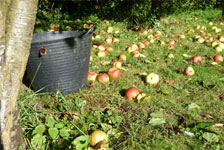 | The apple crop, which had not been radically thinned produced vast quantities of good-sized apples which fell off the trees when the first rains and gales came in early October. The first half of October was then spent in a flurry of chutney making, apple and blackberry crumble consumption plus putting some bags in the freezer for the winter. |
Nature’s autumn harvest of blackberries was good and Nigel made several ‘picking’ trips to the local hedgerows.
| And so with the H&DGC Autumn Show done and dusted and Richard Crane’s winning pumpkin sitting in glorious splendour ready for Halloween, a glorious year of gardening ended. Just my Christmas list of all my new tool and seed requirements to write now …. Have a happy one. |  |
Diana,
Chairman H&DGC
|
| (Top of page) |
The Gardening Year 2012 |
|---|
|
It all started so well – temperatures at 10°C, a bit of wind but little frost – we began to wonder whether winter was coming at all. Crocus in a tub flowered on the 17th of Jan and the public daffodils in Haverhill opened on the 20th of Jan. The first snowdrop started flowering on the 27th Jan and our own tête-à-têtes at the triangle flowered as Feb turned to March. Compare that to last year after the long cold winter when they flowered in last March, nearly a month later than usual - goodness me!
There is always a disadvantage if it does not get cold enough – plants don’t quite rest enough, so I was quite pleased when we did have a good cold snap in the first few days of Feb. Then 150mm (6”) of snow fell and the temperature plummeted to -11C. As this cold spell ruled out garden activity, it was lovely to have the indoor bulbs in full flower. Extra large Amaryllis bulbs will produce two or three stems with 3, 4 or 5 flowers per stem in single of double forms and the range of peach to red colours really cheer up cold, grey days. Hyacinths contribute columns of waxy, starry flowers and scent which fills the whole house with the smell of Spring to come. If you don’t normally grow these bulbs, I highly recommend you add them to your indoor floral menu.
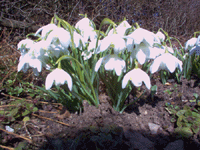 | | The snowdrops proceeded to put in their appearance after the snow and it stayed cold keeping the snowdrops bright and fresh for an extended period. Apart from the 23rd Feb when Spring showed her hand at 17°C, we had to wait until the 12th of March before some beautiful weather came along, but when it did, it was glorious. Day after day of pure sunshine and blue skies with gentle breezes. The garden visibly grew every day and patches of bare earth were swallowed up by the swelling growth of shrubs as leaves unfurled to their full size. |
Some plants as always had not enjoyed the cold. Dahlias left in the ground were casualties and as the temperature dropped below -12C, Garriya, Weigelia’s and even ivy suffered from frost burn. I thought I had lost a variety of Inula from seeds I originally bought at Christopher Lloyd’s garden but fortunately through lack of autumn pruning, this had self-sown itself elsewhere. You can’t get through a winter without some plants going, but this merely provides the opportunity to refresh the garden with something new and that makes it a place of constant interest. At the end of March, hyacinths in tubs looked magnificent alongside primroses, daffodils and wallflowers, making a very colourful display for early in the year.
On April the 5th I planted my gladioli ready for the class in the Annual Show on July 14th. This is the second year of testing this ‘100 days to flower’ theory. Last year it did not work as the Spring was too dry.
The beautiful, clear, blue-skied days of March at 21C led to the inevitable – the declaration of a drought and an immediate and long-lasting hosepipe ban for our area, unless you were exempt due to disability or using seeping hoses on timers. And in its turn, that too could only mean one thing – the heavens opened and April had 107mm of rain and stayed stubbornly cold through out the month. The garden was grateful for the moisture but so were the slugs and snails.
| As soon as some warmth crept in, the slugs appeared in their hundreds. Certain plants such as my border Tradescantia were positively ‘dripping’ in the large, brown ones on a couple of occasions. I have never seen anything like it. I wouldn’t mind if the birds would feed their young on them, but they don’t – no-one wants them! I could do with a pet hedgehog that I could just place where I have a problem periodically. I do have a pile of logs in the garden, but there was no sign of a hedgehog around and if he was there, he was probably slowed down by being too fat from eating so many. | | 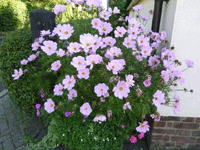 |
Slowly in May the temperature rose. In preparation for the Gardeners’ Mart on the 26th May, I still had bubble wrap protection up in the greenhouse two weeks before the Sale. I can’t recall ever being so late. The last frost I recorded was on the 11th May. In the final week to the Mart, the sun came out in full strength and flower stems shot up and just opened in time for the big day. Sometimes it feels like I am preparing for the Chelsea Flower Show rather than the Mart, (which is on around the same time), trying to get things to look their best for that one morning. And on the day itself it was pure sunshine and 28°C and we had fantastic support and just about sold out of everything we had. Thank you everyone who came and bought from us, and Zoe’s coffee and cake stall had a rip-roaring morning as well. The cold Spring had meant a very difficult start for veg this year so it was no surprise to find very little on offer at the Mart this year, but we will try and offer more again next year.
The rain and the sun had made the garden grow, not just a little but a huge amount. Lupins bushes threw up more than a dozen spires, delphiniums grow to 1.85m and were splendidly clad in long columns of florets in shades of mauves and blues. A top tip here – people are always concerned about these plants being eaten by slugs and snails. If you can control those pests when the plants are young, as they reach mature specimens of say three years old, they leap out of the ground quite early at the end of Feb, getting some height on them before the slugs really wake up in April. In that time, the stems develop some woody strength at the base instead of fleshy green, that is not so attractive to pests and they suffer much less damage.
Geraniums and petunias, on the other hand, were not so happy. As soon as May turned to June the cold, wind and rains returned and after the Diamond Jubilee weekend, heavy showers followed for the rest of the week. The ground remained stubbornly cold and few direct-sown seeds germinated of either flowers or veg. The delpiniums and lupins broke and scattered in the wind and the wreckage was placed in vases in the house where I thoroughly enjoyed them. It was hard to keep on top of hedge trimming, strimming, creeping buttercup growth, spreading nettle patches, grass growing between paving slabs and a million other jobs. You need dry spells in between, but the ‘drought’ wasn’t having any of it, and the rain kept coming. I do recall that in the summer of 1976, after the long hot summer, when the weather broke in the September we had the wettest September on record for 60 years. It seems that mentioning the word ‘drought’ is all you have to do to end one!
Other casualties of this year were birds and butterflies. Our bluetit parents seemed to become only one parent and then deserted at the point of the youngest fledging. This was a very sad Sunday afternoon at the beginning of June. The three pairs of magpies that have taken up residence probably did not help and their numbers need radically controlling in my view. Hearing them go up and down the hedgerows with blackbirds screaming as their eggs are taken is not nice. Butterflies suffered from the warm then wet, cold spring and many of these were lost too.
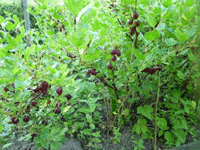 | | It should have been strawberry season as Wimbledon started at the end of June, but there were none in my garden. The few plants I have had tiny green fruits but not a juicy, red fruit in sight. Monty Don on Gardeners’ World was saying ‘it’s not too late to plant veg as the warm soil and warm evenings in Sept and October are still good for ripening’. I spoke to three commercial nurseries at this time, all of whom had greenhouses and poly tunnels full of summer flowers and who said there were no customers and no interest this year as it was too cold and wet. |
Meanwhile, the roses put in an appearance and suddenly the garden became calmer and full of the scent that is so ‘English’. The resurgence of interest in old-fashioned rose shapes means there are some absolutely fabulous specimens on offer to fit every size, shape and space you have available. If you don’t believe me, visit the flower beds in St Andrew’s Church, Hempstead to see how glorious some of them can look. The Salvia ‘Hot Lips’ on the front of the left hand border often attracts comment as it is so dainty and the flowering season is so long. A good ‘doer’ as old gardeners say.
My pots and hanging baskets started to fill out. I have these around the patio and shed as there is just never enough room in the beds and borders and I love the fact I can grow different things in them. Every year I pick a different menu of plants for the hanging baskets and different colour palettes for different locations near the house. This year’s selection included trailing begonias, million bells, trailing fuchsias, the new, white trailing allysum, brachycome, trailing nemesias in hot colours, bidens, and trailing petunias. They looked great (for a short while) and it is very relaxing to stroll around watering and dead-heading them in the evenings. The nicotiana around the edge of the patio, throw up their heads and release their scent at this time of day, and in an enclosed warm space, are enchanting. They also attract lovely moths as do the night scented stocks. Find a space near the house for these next year if you missed trying them this year.
The Annual Show on July 14th was short of veg as predicted, but managed surprisingly well in other areas and the Show was a good success bearing in mind how difficult conditions had proven with 37mm (1.5”) of rain in the week leading up to the Show itself. This rain proved too much for the Horse & Pony Show and the Classic Vehicle Gathering both of which were cancelled as a consequence of the wet ground. A drier spell followed but as soon as the school holidays started another 25 mm (1”) of rain fell.
| The temperature remained below 20C for most of August but with less rain and gentle breezes, the garden settled down. The sunshine of September then brought the borders into their full glory and they were a joy for these few weeks. Banks of phlox, alstromeria, lynchis coronaria, Shasta daisies, monarda and more all blended into a wonderful rich mix of colour and made the strife of the earlier months all worthwhile. | | 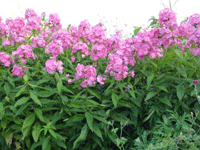 |
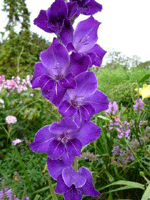 | | And what of my ‘100 day’ gladioli trial? The first stem flowered at 131 days and the last at 162 days – all with beautiful flowers but missing the Annual Show by a mile! The best of the varied colours I tried was a beautiful dark purple with a feint hint of white, edging each flower. To grow these again I will put them in a row, as you would in a veg patch, and grow them with good stakes and support. They are space efficient, fantastic either cut for the house or left in the garden, and last well. These are my top tip for the next fashionable flower. Put them on your list for 2013. |
The veg patch produced its reliable potato and bean crops with Charlotte being the best performing potato with the least damage and we avoided the blight that many suffered. The fruit cage crop of gooseberries was good but currants and raspberries were few and far between. Lettuce put in a good performance in August and September but there was not a courgette in sight. Rhubarb lasted well in the cooler, wetter conditions this year but few outdoor crops relished this cold, wet summer.
In the greenhouse, all the types of tomatoes we grew did reasonably well and flavour was surprisingly good considering the limited sunshine, but the star of the greenhouse by far was the melons – yes, melons! The fantastic flavour of these small fruits instantly made you think of sitting on the Italian Riviera with a plate of melon and prosciutto ham in front of you and a glass of chilled, white wine in your hand. And the scent of the ripe fruits in the kitchen was gorgeous. Something good to end the year on at last!
And that really was it. As I write now, the temperature has plummeted to 4C and a biting north wind is blowing. Pots have been moved to dry, frost-free storage and rotting plant stems are rapidly being removed. The best stems will stay for architectural, winter effect and those with seeds will remain for the birds. I fear a hard winter this year, so give all wildlife a thought, and do what you can to help them every day with food and water. Best wishes!
Diana Frost
|
| (Top of page) |
The Gardening Year 2011 |
|---|
|
How the winter of 2010/11 dragged on, but it only heightened the joy of seeing the first snowdrops and aconites appear in mid February giving the first glimmer of better days to come. The additional snowdrops planted across the centre of the Ring o’ Trees made a good vista from The Bluebell Inn and the 750 new crocus planted under the sign at the bottom of Church Hill gave a lovely display in the first week of March.
And suddenly it was a rush to clear up the garden from its winter shroud. Hedges needed cutting, dead stems and leaves needed cutting and raking, bittercress needed weeding before it spread, the greenhouse needed cleaning and tidying and best of all – it was time to plant seeds!
There is nothing better than sieving some compost, damping it down, sprinkling a packet of almost invisible seeds on it and putting it on a windowsill to germinate. Many seeds only require 15-20C to geminate which is normal house temperature with a little central heating. As little as a week later, the soil erupts and up pop tiny stems of promise. Big seeds make big eruptions – even more fun!
Very slowly the temperature started to climb and a cool March gently gave way to warm, sunny days in April. There were no blustery showers or strong, east winds and as April progressed we became more and more aware of the lack of rain. Cracks appeared in the fields, primulas, primroses and other early bloomers held their flowers for much longer than usual and the warmth brought the development of many plants on faster than normal.
By the end of April and beginning of May, the garden was looking decidedly unbalanced.
Delphiniums, not usually in flower until June, opened their first flowers at the end of April among the daffodils and tulips and a magnificent show of lupins filled the flower beds accompanied by aquelegias, pulsatillas, aubretia, sweet rocket and more. It was beautiful, but it was also frightening. Nature should not be so extreme and after a long dry period during last summer and the very harsh winter, this only added to the list of imbalances.
The bluetits and great tits took up residence in every nestbox we possess, with busy parents almost flying over each other as they took their favourite flight route back to their youngsters. With so little rain, and therefore perhaps fewer soft bugs and insects in the trees, I thought they ate more sunflower seed from the bird table this year, but it was difficult to tell.
By May, farmers of vegetable crops were watering the fields continuously while the arable landscape that we are more familiar with, of barley, wheat, rape and field beans, produced the shortest height crops I have seen for years. Wheat heads that were not filled with corn, were light and airy if you squeezed them. The crop may have been standing upright but it was not as it should have been.
The Gardeners’ Mart took place around the bus shelter in Hempstead on the 21st May. I worried that since no-one could actually get a fork in the ground, that the garden plants would not sell, but we are a resilient and trusting bunch, we gardeners, and knew that rain would come. June arrived, and so, thankfully, did the rain. And it was the right sort of rain – long, slow, gentle spells every couple of days that get into the ground properly. Nobody minded after such a barren Spring, and whereas normally we would be thinking of enjoying the garden furniture, no-one seemed bothered that it was sitting in the garden doing nothing.
You can always plant a tub or a pot or a hanging basket, or a raised bed with compost from a bag, and that avoids all the problems of hard, clay soil in the ground, so the village took on a lovely new colour as all these additions were made. And they present the opportunity to try out something you have not grown before because you can watch it at close quarters and water it regularly.
On June 3rd my first roses opened. Last year had been a very good year for roses after the cold winter of 2009/10, but with the winter being so harsh last year, I expected that a good show two years on the trot was probably unlikely. I could not have been more wrong. The blooms were bountiful and perfect until the rains damaged them, but if you walked through the churchyard and stopped to look at the climbing roses in the beds by the porch, they would have made you smile. And the evening scent on a still night was glorious.
Wimbledon started in the cool, showery days that we know so well, where breaching 20C seems to be just beyond the weathers capability, but the middle Monday of the tournament showed a burst of temperature to 29C that caught us all out. It did not last and normal conditions resumed.
By now, the vegetables were coming on stream, well, those that has not been eaten by the muntjac, or dug up by the moles, or nibbled by the pigeons, or infested with greenfly or anything else that had chosen to have a go at them. It was deeply depressing. Months of hard work and expense going to waste. Thankfully the fruit cage produced wonderful raspberries, redcurrants and gooseberries. The problems made us want to cover the rest of the veg patches, but that is ridiculously expensive and inconvenient and you should not have to. No gardener minds sharing the odd thing with nature, that’s normal, but decimation is another matter all together.
And the lawn was under attack too. Over the last three years the black and red ant nests in the lawn have got bigger and bigger. By June I had used three large tubs of ant powder on the lumps that kept rising in the grass and was still nowhere near on top of the problem. The cold winter had not reduced their numbers at all. If anyone has a solution, please share it. And before I leave the topic of pests and diseases, I also noted far less red lily beetle this year and a burst of ladybirds in late summer.
As July arrived the flower borders hit perfection. I always like to let Lynchis coronaria seed itself around the garden as the soft, silvery foliage and airy cerise flowers make a perfect ‘filler’ in every part of the garden. Some plants are just good ‘doers’ and this is one of them.
A few dry days at the beginning of July were perfectly timed to allow the pots of lilies to open and stand majestically. The colour range of these is wonderful as you can choose solid, bold colours in traditional yellows and oranges, or those with speckled tongues in soft whites, pinks and clarets, or two tone shades, or speciality ones, of which I love Eyeliner. Each petal of pure white has a black line around its edge, making its colour and definition stand out even more.
The Annual Show came one week too late for the very best results from flowers in the garden and the biggest frustration were the gladioli that would not flower. The intention was to have perfect blooms for the Show which allegedly take 100 days from planting the corm. I can only assume the dryness was the problem as they did not get started quickly enough. In fact my last one, a bi-colour, opened on September 10th! We will give this another go next year and see if different conditions produce different results.
Throughout late July and August the herbaceous borders were a perfect picture. They soaked up every drop of rain that fell steadily every second or third day, benefitting from never struggling for water, with full green leaves all the way up the stems. I didn’t once reach for a hose during this period and my collection of phlox’s were at their best ever, in shades of pale pink, medium pink, mauve and violet. Monada (Bergamot) also had an excellent year as did salvias, batchelor’s button, helleniums, summer clematis and many more. Of course one group of plants that were not quite so happy were the geraniums, as the water destroys their multi-headed blooms and ruins the petals. But you can’t have everything.
Runner beans and in fact all the bean crops, burst forth during the week August and suddenly we were inundated with trugs of produce. The courgettes were not far behind, but the tomatoes did not fair so well in some substantial compost in the greenhouse. The plum tree gave of her best, despite loosing a branch on a particularly windy day, and with fairly limited wasp invasion due to the wet conditions. We managed to pick the whole crop before much fell and perished. And of course, the August rain swelled the already heavy crop of apples to the point where I thought every tree would break. Even the Egremont Russet took on a more dramatic lilt than usual and as we turned the corner to September with instant delivery of the first autumn Atlantic lows blowing in, fallen fruits could be gathered every day in high quantities. The combination of conditions this year actually brought the apples on 2-3 weeks early. The weather settled down again though and September and October proved to be beautiful, warm months and we had the highest ever temperature of 29.4C recorded on Sunday 2nd October. The geraniums and hanging baskets prospered again. new cosmos stems flowered, the dahlias looked magnificent, evening primroses opened and it felt like summer would never end…
With the abundance of fruit and apples this year, how appropriate it was that one class of the Gardeners’ Club Autumn Show should be a spiced apple pie (provided you could store your apples for long enough!). And there were a dozen entries who competed for the Domestic Trophy, eventually won by young Harris McCarthy.
Eventually the dark and cold nights arrived in mid October. The final ‘cutting down’ of the garden is always a chance to look over the condition of everything and ponder alterations. It is time to make alterations to hedges and do that hard cutting back that will give them a much better shape for future years. It is also a chance to do some maintenance on them which you cannot do in summer, including reducing excessive weeds or unwanted stems and giving them a much needed feed and mulch. If you are tackling serious hedge reduction, remember it takes three years – first year one side, second year the other side, third year the top. But this is well worth doing as you then have a lovely hedge for the next 10 years. Smaller cutbacks can be done in one go.
And the shed always needs a clear out before all the pots are stored away for winter. Chuck out all the unwanted remnants of products that will not over-winter, sharpen tools, take note of what you needs replacing or is running out – so when you get asked what you want for Christmas – you might actually get what you want this year!
Happy gardening.
Diana Frost
|
| (Top of page) |
The Gardening Year 2010 |
|---|
|
As the winter of 2009/10 proved to be the coldest for over 20 years, January and February can easily be dismissed for commentary 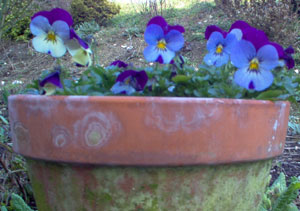 as it was far too cold to be outside and no gardening took place. The depth of frost in the ground was notable to at least 100mm (4”) so at least we should have killed off some pests and diseases this year. Walking on frosted grass tends to kill it off though, so there was no point in inspecting the garden as you do more damage than good, so we waited for warmer days. as it was far too cold to be outside and no gardening took place. The depth of frost in the ground was notable to at least 100mm (4”) so at least we should have killed off some pests and diseases this year. Walking on frosted grass tends to kill it off though, so there was no point in inspecting the garden as you do more damage than good, so we waited for warmer days.
If you count winter as December, January and February in broad terms, then the ‘last day’ of winter was a howler. A deep ‘low’ (Atlantic storm) swelled up from Spain and Portugal killed 45 people on the Atlantic coast of France as it travelled north-east and fortunately only grazed the south-eastern tip of England with wind and rain.
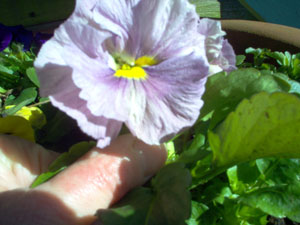 March 1st arrived, and in the true fashion of ‘the quiet after the storm’, it was a beautiful day with no wind, blue sky and pure sunshine - such a contrast to recent times and so good to see the sun at last! It did not mean however that warmth was on the way, and doggedly the daytime temperature would not move above 6C with sharp frosts at nights. Time to check the nest boxes and make sure they are clean, secure and dry for this season’s (bird) customers, who needed a lot of feeding with seeds and fat balls this year to help them through the cold winter. March 1st arrived, and in the true fashion of ‘the quiet after the storm’, it was a beautiful day with no wind, blue sky and pure sunshine - such a contrast to recent times and so good to see the sun at last! It did not mean however that warmth was on the way, and doggedly the daytime temperature would not move above 6C with sharp frosts at nights. Time to check the nest boxes and make sure they are clean, secure and dry for this season’s (bird) customers, who needed a lot of feeding with seeds and fat balls this year to help them through the cold winter.
The snowdrops opened and the cold weather gave us the benefit of a long lasting display. This also gave us a longer time to divide and move the bunches after flowering (’in the green’). We will extend the rather sparse display in the Ring o’ Trees for 2011.
It was noted that the small daffodils at the triangle that we all pass in our cars every day were a full month behind in blooming this year, and the garden daffodils put on a spurt of growth when the figures hit double digits and started to bloom in the last week of March.
Plug plants faired better in the greenhouse than propagated seeds which struggled in the low light levels and with the cold nights. Nothing grew quickly and the evidence was there to see in the Garden Centres, who equally struggled to supply good quality young plants for purchase. I suspect prices will be high come peak season for basket and bedding plants in May this year, to offset the high costs of heating that have been used to get the plants to grow.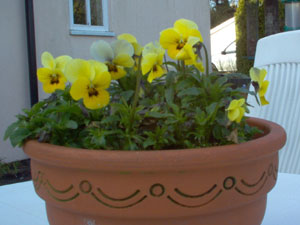
Very slowly they reached double figures and the plants in the greenhouse came to life. It was short lived and heavy rain and wind set in for the last week of March bringing deep snow to Scotland. The greenhouse came to a standstill again and in the beds and borders there was time to weed the dreaded bitter-cress before it seeded too far, and remove the perennial weeds that had spread during winter.
The growth of algae and moss on furniture, pots, compost bins, tree branches and especially the lawn seemed much worse than in previous years, so early April was spent cleaning the furniture and pots but with the lawn having to wait for warmer weather in late April or May, otherwise you just drag the good grass out by the roots with the moss.
April is also the time to get to grips with your pots of lilies and red lily beetle. This pest has become far more prevalent in recent years and action is needed before the plants produce their leaves which will turn to a sticky black mess on the undersides from this beetle’s eggs and secretions. As it is bright red it is easy to see, but cup your hand underneath as you try to remove them as their defence mechanism is to fall to the bottom of the stems and get lost in the leaf junctions. They need to be destroyed or they will re-infest the plant.
While sun levels were good in April, it was also exceptionally dry and this was followed by a dry May too. The 10mm of rain at the end of the first week was vital as there was precious little else in the month. The big demon of this month proved to be the intense late frosts on the 10th and 11th which killed off any soft fleshed squashes and tender plants that had ventured from the protection of the greenhouse, cold frame or poly tunnel. Fruit blossoms managed to survive better than expected which was good since this has been a fantastic year for blossom and bodes well for a good fruit crop later in the season. I did loose my new Pluot tree – a combination of an apricot and plum which I was experimenting with. It has survived perfectly happily through all the snow and ice of winter, but the hot sunny days of early May and these two bitter nights were too much and death was immediate.
All of the above though, meant that by the time we held the Gardeners’ Mart on Saturday 22nd May, there was pent up spending in Hempstead waiting to be unleashed. And we had the answer for it. On a perfect day of blue sky, sun, warmth and no wind we presented a fabulous array of flowers, vegetables and plants in very good condition and within an hour and a half we were sold out, selling over £1000 of items who average price was 50p-£1. A great morning and a great boost for Club funds. We sold over 40 courgettes (a reflection of domestic casualties, I think) and 50 tubered dahlias.
Dahlias are beautiful and great value and have been over-looked in recent years as they are considered too blousy. But large borders demand some striking plants and once you get over the initial growth stage and the attempts of slugs and snails to deny you your prize, they are well worth growing. Their late summer addition to the border when other plants have passed their best is terrific. They will need staking against June’s thundery downpours, but they will love the moisture this brings and will put on substantial growth.
The Spring dryness also meant that the grass grew more slowly meaning less lawn mowing, that slug and snail numbers were noticeably down whilst the cold nights meant that the veg patch soil was slow to warm to temperatures suitable for planting out potatoes etc.
Chelsea Flower Show in the pre Bank Holiday week (25-28 May) managed to maintain its high standards of display although many presenters said they took more stock with them this year to overcome failures.
By the end of May/first week of June, the garden had mostly caught up on its late start and the veg patch was fully planted with salads, beans, squashes, carrots etc and the hedges had burst to life so strongly that the first cut was needed. Tulip and daffodil leaves could be removed, delphiniums were at full height, bearded iris and alliums were in full glory and the roses were budding up. In the strawberry patch, the flowers had opened and small fruits were forming and these will be ready for Wimbledon fortnight, right on cue. It is amazing how everything catches up after a late start.
Gardeners and farmers are never satisfied. After the 10 mm of rain on May 1st we had 25mm between the 6th and 8th of June and then the sun came out and the temperature soared here in the East and we did not see rain again until w/c 12th July. In that time, without wind and rain to knock them about, the roses, pot flowering lilies and summer-flowering clematis gave the most magnificent displays. The 20 year old Queen Elizabeth rose outside my back door, which I rather riskily cut hard back into the old wood last winter, produced over 100 blooms in its first flush and the rambler by the front door smelt heavenly in the warm, still evenings.
Anything that was watered during this period performed very well, and summer bedding plants came on quickly with the combination of evening watering and daytime sun, but the rest of the garden turned quickly to a crisp. Lawns went brown, poppies collapsed, phlox shed all their lower leaves and drooped, the stems of astrantia bent in half and only the tough old hardy plants such as yellow loosestrife, red hot poker, achillea and day lilies, really coped well.
In the fruit cage, assisted by some watering, the redcurrants and gooseberries looked good but raspberries stayed smaller in size. There was no question of getting a fork in the rock-hard ground and the lawn mower has one of its most redundant spells, only putting in an appearance once a fortnight rather than twice a week as is common at this time of year.
The Hempstead Annual Flower Show on Saturday 10th July, whilst well-attended with over 300 entries, showed the effects of the late frost and recent dry spell with vey few vegetables ready. Trusty courgettes had just come on stream and lettuce were in good form for having very few slugs and snails around, but carrots and greens generally were scarce and potatoes were prone to scab.
There were relatively few vases of flowers in the Show and I will write to encourage everyone to find a strip to grow some cut flowers in future, and recommend some varieties to include.
Late July weather was very average, as was the first half of August. The 14mm of rain that fell on the 10th were welcome for the garden but not for those on holiday. Hopefully it will help swell apples which are barely half size at present and we are still waiting to harvest plums which have stayed stubbornly green in the damper conditions of recent weeks. The wasps look thoroughly dejected being made to wait so long for their favourite food. Our pear tree is having a year off this year with almost no fruit having produced two bumper harvests in the last couple of years. It deserves a rest and with the fickle dry/wet conditions of this year, it picked a good year to do it.
The weather men say that the Jet Stream has moved to its autumn position of sitting south of the UK, putting us in the run of Atlantic lows which pile in one after the other. I think summer has departed early. By contrast, where the curve of the Jet Stream is up in the Baltic, Russia has been burning up in 30-40°C degrees since early June and the harvest is ruined while Pakistan has its worst floods for 80 years.
Meanwhile, our late planted (really, really late planted) runner beans are happy with the cool conditions and are fast reaching the top of the canes with the first flowers showing. We do not need to water them every night and rain water always produces the better growth than tap water. The greenhouse with its shading of white paint, is producing fantastic crops of cucumbers from two plants and tomatoes are formed but not yet red. The quantity of tomatoes that have set this year seems better that last year where the failure rate was unusually high.
Down by the house my tub of nasturtiums is now disgusting black stalks only. If you ever want to study how amazing nature is, just plant a packet of nasturtium seeds. I have deliberately kept these to see the whole life story. Having propagated the seeds in early May, the plants were transferred to a pot three weeks later and to a large tub four weeks after that. With average compost and plenty of water they grew quickly and good flowers were displayed from late June to late July. The blackfly then took over smothering leaves and stems, which brought in huge quantities of hover flies and ladybirds. At the same time, the Cabbage White butterfly eggs hatched and the developing caterpillars ate every leaf on the plant, hence the bare stalks left behind.
I am reliably informed that at this point you cut the whole plant back to nothing and wait for it to grow again, so my experiment continues – more on this later!
The autumn raspberries started cropping from mid August with better results than the summer ones and there were plenty of courgettes and squashes every day. Blueberries were starting to take on their smoky blue appearance. In the flower beds, dahlias were in full glory now along with inulas, the second flush of roses, phlox, monardas, echinacea, helianthemums, Batchelor’s Button and the beautiful Toad Lilies. The graceful, mid blue agapanthus were revelling in the cramped conditions of their clay pots and were in full flower, but the cannas did not do well. I suspect the soil was not rich enough for these hungry feeders.
It was a good time to collect seeds from the Spring flowering plants and then cut them down, but compost bins needed sorting before a large amount of new material could be added. Cleared spaces in the garden were mulched, full compost bins turned over into vacated spaces, and the newly created spaces filled with new material. When the harvest is in from the nearby fields and on damp evenings, bonfires will clear the non-compostable debris such as blackthorn cuttings from the hedges.
On a couple of nights in late August, the temperatures took a dip to 4C which sent the squashes into heavy mildew on the leaves. With a 50/50 mix of sun and grey skies we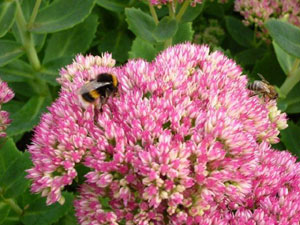 opted to remove the white wash on the greenhouse to give the tomatoes a better chance of ripening and hopefully not scorch the leaves too much. The September forecast remained warm but with plenty of showers until the 17th when the first widespread ground frost was predicted. opted to remove the white wash on the greenhouse to give the tomatoes a better chance of ripening and hopefully not scorch the leaves too much. The September forecast remained warm but with plenty of showers until the 17th when the first widespread ground frost was predicted.
I planted up pots, tubs and baskets of violas to take over from the summer annuals as the frost would kill them off. I prefer violas to pansies as they stay in better shape by Spring. Frost also brings an untimely end to runner beans and dahlias and brings autumn/winter forward making the winter months too long and our precious bees will suffer more. Late summer borders in the garden are beautiful and are important to bees which must store up supplies for winter at this time. If it gets too cold too quickly, they will not have enough stores to survive. The more people who can take up bee-keeping the better.
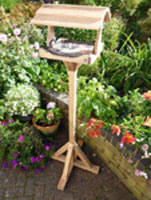 My new RSPB bird table with wide roof proved very successful at keeping the pigeons and crows away, while the greenfinches, great tits, blue tits and gold finches thought it was terrific and paused there for 5 minutes at a time. Further up the garden, the apple trees started to drop their produce as the autumn winds gathered strength. The young 3 way multi-tree did well on 2 of its types but the Egremont Russet tree produced small fruits and needed more thinning of the fruits earlier in the season. The late September sun kept the geraniums blooming well until the wet and gusty weather in the first week of October. Some people keep them over winter, but I find they are not as good in the second year, and usually don’t bother. My new RSPB bird table with wide roof proved very successful at keeping the pigeons and crows away, while the greenfinches, great tits, blue tits and gold finches thought it was terrific and paused there for 5 minutes at a time. Further up the garden, the apple trees started to drop their produce as the autumn winds gathered strength. The young 3 way multi-tree did well on 2 of its types but the Egremont Russet tree produced small fruits and needed more thinning of the fruits earlier in the season. The late September sun kept the geraniums blooming well until the wet and gusty weather in the first week of October. Some people keep them over winter, but I find they are not as good in the second year, and usually don’t bother.
Before starting to do any major cutting down at the end of the season, it is time to collect seeds from the summer flowering plants and vegetables. Many plants produce viable seeds and in these cost-constrained days, it is well worth buying a packet of small brown envelopes and taking a trip round your garden with a pen in your hand and writing on the packets as you find seeds to save. There is nothing more rewarding to a gardener than free seed producing next year’s goodies!
A garden needs some later flowering plants and I always like to have something for the Autumn Show in mid October. The roses produced a good second flush, the phlox has a second burst of life, the aconitums always produce their fine, rich, purple heads at this time and the late yellow flowering daisies at 5’ tall have the upper garden to themselves in this late season. The Michaelmas daisies are also reliable, provided you stake the weaker varieties, and the dahlias were still producing good blooms. Even the zinnias and penstomens still had new spikes of flowers on them. Grouped together these all make a colourful late display in the borders while in the dry garden, the sedum looks majestic and was regularly visited by butterflies and insects as a late feeding station.
The trial of letting the nasturtiums grow up as second time proved very successful, and a tub of lovely flowers was to be seen by my front door in mid October. I had only added water to the congested tub, so this was a real bonus.
The season of leaf collecting, filling compost bins and bonfires was upon us all too quickly and the first frosts take their toll of the garden. When all the clearing up is done, the tools cleaned and put away, and the garden reduced to its skeletal structure for winter, the only thing left to do is review the photos you took of the garden this year and plan for next year. Time for a glass of that sloe gin I made last year, I think
Happy Christmas.
|
| (Top of page) |
|
